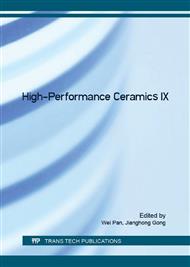[1]
W. Li, K. Lu, J.Y. Walz, et al., Effects of rod-like particles on the microstructure and strength of porous silica nanoparticle composite, J. Am. Ceram. Soc. 96 (2013) 398-406.
DOI: 10.1111/jace.12128
Google Scholar
[2]
J.C. Han, L.Y. Hu, Y.M. Zhang, et al., In situ synthesis of hierarchically porous silica ceramics with unidirectionally aligned channel structure. Scripta Mater. 62 (2010) 431-4.
DOI: 10.1016/j.scriptamat.2009.12.019
Google Scholar
[3]
F.Z. Zhang, T. Kato, M. Fuji, et al., Gelcasting fabrication of porous ceramics using a continuous process. J. Eur. Ceram. Soc. 26 (2006) 667-71.
Google Scholar
[4]
X.H. Zhu, D.L. Jiang, S.H. Tan, et al., Improvement in the strut thinkness of reticulate porous ceramics, J. Am. Ceram. Soc. 84 (2001) 1654-1656.
Google Scholar
[5]
F.K. Yang, C.W. Li, Y.M. Lin, et al., Effects of sintering temperature on properties of porous mullite/corundum ceramics. Mater. Let. 73 (2012) 36-9.
DOI: 10.1016/j.matlet.2011.12.087
Google Scholar
[6]
J.M. Thomas, B.F. G, Johnson, R. Raja, et al., High performance nanocatalysts for single-step hydrogenations. Acc. Chem. Res. 36 (2003) 20-30.
DOI: 10.1021/ar990017q
Google Scholar
[7]
O.D. Velev, T.A. Jede, R.F. Lobo, et al., Microstructured porous silica obtained via colloidal crystal templates, Chem. Mater. 1998, 10 (1998) 3597-3602.
DOI: 10.1021/cm980444i
Google Scholar
[8]
R.A. Caruso, M. Antonietti, Silica films with bimodal pore structure prepared by using membranes as templates and amphiphiles as porogens. Adv. Funct. Mater., 12 (2002) 307-12.
DOI: 10.1002/1616-3028(20020418)12:4<307::aid-adfm307>3.0.co;2-9
Google Scholar
[9]
R.F. Chen, C.A. Wang, Y. Huang, et al., Ceramics with special porous structures fabricated by freeze-gelcasting: using tert-butyl alcohol as a template, J. Am. Ceram. Soc. 90 (2007) 3478-3484.
DOI: 10.1111/j.1551-2916.2007.01957.x
Google Scholar
[10]
O. Lyckfeldt, J.M.F. Ferreira, Processing of porous ceramics by starch consolidation, J. Euro. Ceram. Soc. 18 (1998) 131-40.
Google Scholar
[11]
O.D. Velev, T.A. Jede, R.F. Lobo, et al., Porous silica via colloidal crystallization, Nat. 389 (1997) 447-448.
DOI: 10.1038/38921
Google Scholar
[12]
D.B. Kuang, T. Brezesinski, B. Smarsly, Hierachical porous silica materials with a trimodal pore system using surfactant templates, J. Am. Chem. Soc. 126 (2004) 10534-10535.
DOI: 10.1021/ja0470618
Google Scholar
[13]
C.R. Rambo, H. Sieber, Novel synthetic route to biomorphic Al2O3 ceramics. Adv. Mater. 17 (2005) 1088-91.
DOI: 10.1002/adma.200401049
Google Scholar
[14]
U.T. Gonzenbach, A.R. Studart, D. Steinlin, Processing of particle-stabilized wet foams into porous ceramics, J. Am. Ceram. Soc. 90 (2007) 3407-14.
DOI: 10.1111/j.1551-2916.2007.01907.x
Google Scholar
[15]
H. Nishihara, S.R. Mukai, D. Yamashita, et al., Ordered macroporous silica by ice templating, Chem Mater, 2005, 17: 683-689.
DOI: 10.1021/cm048725f
Google Scholar
[16]
Y.M. Zhang, L.Y. Hu, J.C. Han, et al., Soluble starch scaffolds with uniaxial channel structure for in situ synthesis of hierarchically porous silica ceramics, Micropor. Mesopor. Mat. 130 (2010) 327-32.
DOI: 10.1016/j.micromeso.2009.11.030
Google Scholar
[17]
W. Wan, Y.B. Feng, J. Yang, et al., Preparation of mesoporous silica ceramics with relatively high strength from industrial wastes by low-toxic aqueous gel-casting, J. Eur. Ceram. Soc. 35 (2015) 2163-2170.
DOI: 10.1016/j.jeurceramsoc.2015.01.011
Google Scholar


